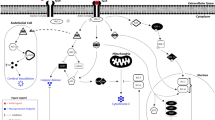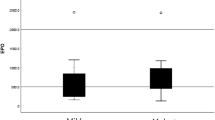Abstract
Background
Erythropoietin (EPO) and its receptor play a major role in embryonic brain, are weakly expressed in normal postnatal/adult brain and up-regulated upon metabolic stress. EPO protects neurons from hypoxic/ischemic injury. The objective of this trial is to study the safety and efficacy of recombinant human EPO (rhEPO) for treatment of ischemic stroke in man.
Materials and Methods
The trial consisted of a safety part and an efficacy part. In the safety study, 13 patients received rhEPO intravenously (3.3 × 104 IU/50 ml/30 min) once daily for the first 3 days after stroke. In the double-blind randomized proof-of-concept trial, 40 patients received either rhEPO or saline. Inclusion criteria were age <80 years, ischemic stroke within the middle cerebral artery territory confirmed by diffusion-weighted MRI, symptom onset <8 hr before drug administration, and deficits on stroke scales. The study endpoints were functional outcome at day 30 (Barthel Index, modified Rankin scale), NIH and Scandinavian stroke scales, evolution of infarct size (sequential MRI evaluation using diffusion-weighted [DWI] and fluid-attenuated inversion recovery sequences [FLAIR]) and the damage marker S100ß.
Results
No safety concerns were identified. Cerebrospinal fluid EPO increased to 60–100 times that of nontreated patients, proving that intravenously administered rhEPO reaches the brain. In the efficacy trial, patients received rhEPO within 5 hr of onset of symptoms (median, range 2:40–7:55). Admission neurologic scores and serum S100β concentrations were strong predictors ofoutcome. Analysis of covariance controlled for these two variables indicated that rhEPO treatment was associated with an improvement in follow-up and outcome scales. A strong trend for reduction in infarct size in rhEPO patients as compared to controls was observed by MRI.
Conclusion
Intravenous high-dose rhEPO is well tolerated in acute ischemic stroke and associated with an improvement in clinical outcome at 1 month. A larger scale clinical trial is warranted.






Similar content being viewed by others
References
The National Institute of Neurological Disorders and Stroke rt-PA Stroke Study Group. (1995) Tissue plasminogen activator for acute ischemic stroke. N. Engl. J. Med. 333: 1581–1587.
Zhu Y, D’Andrea AD. (1994) The molecular physiology of erythropoietin and the erythropoietin receptor. Curr. Opin. Hematol. 1: 113–118.
Jelkmann W. (1994) Biology of erythropoietin. Clin. Invest. 72: S3–S10.
Brines ML, Ghezzi P, Keenan S, et al. (2000) From the cover: erythropoietin crosses the blood-brain barrier to protect against experimental brain injury. Proc. Natl. Acad. Sci. U.S.A. 97: 10526–10531.
Juul SE, Anderson DK, Li Y, Christensen RD. (1998) Erythropoietin and erythropoietin receptor in the developing human central nervous system. Pediatr. Res. 43: 40–49.
Marti HH, Wenger RH, Rivas LA, et al. (1996) Erythropoietin gene expression in human, monkey and murine brain. Eur. J. Neurosci. 8: 666–676.
Morishita E, Masuda S, Nagao M, Yasuda Y, Sasaki R. (1997) Erythropoietin receptor is expressed in rat hippocampal and cerebral cortical neurons, and erythropoietin prevents in vitro glutamate-induced neuronal death. Neuroscience 76: 105–116.
Lewczuk P, Hasselblatt M, Kamrowski-Kruck H, et al. (2000) Survival of hippocampal neurons in culture upon hypoxia: effect of erythropoietin. Neuroreport 11: 3485–3488.
Bernaudin M, Bellail A, Marti HH, et al. (2000) Neurons and astrocytes express EPO mRNA: oxygen-sensing mechanisms that involve the redox-state of the brain. Glia 30: 271–278.
Masuda S, Okano M, Yamagishi K, Nagao M, Ueda M, Sasaki R. (1994) A novel site of erythropoietin production. Oxygen-dependent production in cultured rat astrocytes. J. Biol. Chem. 269: 19488–19493.
Sirén AL, Knerlich F, Poser W, Gleiter CH, Bruck W, Ehrenreich H. (2001) Erythropoietin and erythropoietin receptor in human ischemic/hypoxic brain. Acta. Neuropathol. (Berl) 101: 271–276.
Bernaudin M, Marti HH, Roussel S, et al. (1999) A potential role for erythropoietin in focal permanent cerebral ischemia in mice. J. Cereb. Blood Flow Metab. 19: 643–651.
Sadamoto Y, Igase K, Sakanaka M, et al. (1998) Erythropoietin prevents place navigation disability and cortical infarction in rats with permanent occlusion of the middle cerebral artery. Biochem. Biophys. Res. Commun. 253: 26–32.
Sakanaka M, Wen TC, Matsuda S, et al. (1998) In vivo evidence that erythropoietin protects neurons from ischemic damage. Proc. Natl. Acad. Sci. U.S.A. 95: 4635–4640.
Sirén AL, Fratelli M, Brines M, et al. (2001) Erythropoietin prevents neuronal apoptosis after cerebral ischemia and metabolic stress. Proc. Natl. Acad. Sci. U.S.A. 98: 4044–4049.
Nagai A, Nakagawa E, Choi HB, Hatori K, Kobayashi S, Kim SU. (2001) Erythropoietin and erythropoietin receptors in human CNS neurons, astrocytes, microglia, and oligodendrocytes grown in culture. J. Neuropathol. Exp. Neurol. 60: 386–392.
Sela S, Shurtz-Swirski R, Sharon R, et al. (2001) The polymorphonuclear leukocyte—a new target for erythropoietin. Nephron 88: 205–210.
Herrmann M, Vos P, Wunderlich MT, de Bruijn CH, Lamers KJ. (2000) Release of glial tissue-specific proteins after acute stroke: a comparative analysis of serum concentrations of protein S-100B and glial fibrillary acidic protein. Stroke 31: 2670–2677.
Wunderlich MT, Ebert AD, Kratz T, Goertler M, Jost S, Herrmann M. (1999) Early neurobehavioral outcome after stroke is related to release of neurobiochemical markers of brain damage. Stroke 30: 1190–1195.
Eschbach JW, Egrie JC, Downing MR, Browne JK, Adamson JW. (1987) Correction of the anemia of end-stage renal disease with recombinant human erythropoietin. Results of a combined phase I and II clinical trial. N. Engl. J. Med. 316: 73–78.
Adams HP Jr, Davis PH, Leira EC, et al. (1999) Baseline NIH Stroke Scale score strongly predicts outcome after stroke: a report of the Trial of Org 10172 in Acute Stroke Treatment (TOAST). Neurology 53: 126–131.
Buttner T, Weyers S, Postert T, Sprengelmeyer R, Kuhn W. (1997) S-100 protein: serum marker of focal brain damage after ischemic territorial MCA infarction. Stroke 28: 1961–1965.
Beaulieu C, de Crespigny A, Tong DC, Moseley ME, Albers GW, Marks MP. (1999) Longitudinal magnetic resonance imaging study of perfusion and diffusion in stroke: evolution of lesion volume and correlation with clinical outcome. Ann. Neurol. 46: 568–578.
Elting JW, de Jager AE, Teelken AW, et al. (2000) Comparison of serum S-100 protein levels following stroke and traumatic brain injury. J. Neurol. Sci. 181: 104–110.
De Ryck M. (1998) Neuroprotection in animal models of stroke and in clinical stroke trials: a new analysis of infarct size. In Manni C, Delooz H, Della Corte F (eds). First European Congress on Emergency Medicine. Bologna: Monduzzi Editore; 15–22.
Fisher M, Schaebitz W. (2000) An overview of acute stroke therapy: past, present, and future. Arch. Intern. Med. 160: 3196–3206.
Albers GW, Goldstein LB, Hall D, et al. (2001) Aptiganel hydrochloride in acute ischemic stroke: a randomized controlled trial. JAMA 286: 2673–2682.
Dirnagl U, Iadecola C, Moskowitz MA. (1999) Pathobiology of ischaemic stroke: an integrated view. Trends Neurosci. 22: 391–397.
Sasaki C, Kitagawa H, Zhang WR, Warita H, Sakai K, Abe K. (2000) Temporal profile of cytochrome c and caspase-3 immunoreactivities and TUNEL staining after permanent middle cerebral artery occlusion in rats. Neurol. Res. 22: 223–228.
Campana WM, Misasi R, O’Brien JS. (1998) Identification of a neurotrophic sequence in erythropoietin. Int. J. Mol. Med. 1: 235–241.
Marshak DR. (1990) S100 beta as a neurotrophic factor. Prog. Brain Res. 86: 169–181.
Hacke W, Warach S. (2000) Diffusion-weighted MRI as an evolving standard of care in acute stroke. Neurology 54: 1548–1549.
Hacke W, Kaste M, Fieschi C, et al. (1998) Randomised doubleblind placebo-controlled trial of thrombolytic therapy with intravenous alteplase in acute ischaemic stroke (ECASS II). Second European-Australasian Acute Stroke Study Investigators. Lancet 352: 1245–1251.
Acknowledgments
This work has been supported in part by research grants from the Max-Planck Society and from Ortho Biotech Inc. to Dr Ehrenreich. We wish to thank Dr J. Donald Easton for valuable discussions.
Author information
Authors and Affiliations
Corresponding author
Additional information
Contributed by A. Cerami.
Rights and permissions
About this article
Cite this article
Ehrenreich, H., Hasselblatt, M., Dembowski, C. et al. Erythropoietin Therapy for Acute Stroke Is Both Safe and Beneficial. Mol Med 8, 495–505 (2002). https://doi.org/10.1007/BF03402029
Accepted:
Published:
Issue Date:
DOI: https://doi.org/10.1007/BF03402029




